What types of bulbs exist: an overview of the main types of lamps + rules for choosing the best
For the arrangement of lighting, there are various types of lamps. In addition to traditional incandescent devices, other types of bulbs, for example, LED, fluorescent, halogen, have gained distribution.
In the article we will consider the most popular sources of light by users, noting the features of their device, advantages and disadvantages.
The content of the article:
Traditional Incandescent (LON)
A device of this type consists of a base, where the contacts are located, a fuse, an incandescent element and a glass bottle.
The spiral is usually made of an alloy with tungsten, which is able to withstand a high combustion temperature of +3200 ° C for a long time. To extend the burn-out time, the cylinder is filled with argon or another inert gas; in some devices, on the contrary, they create a vacuum.
For the lamp to function, electric current is passed through a conductor having a small cross section and a low degree of conductivity. Energy heats a spiral that emits light waves.
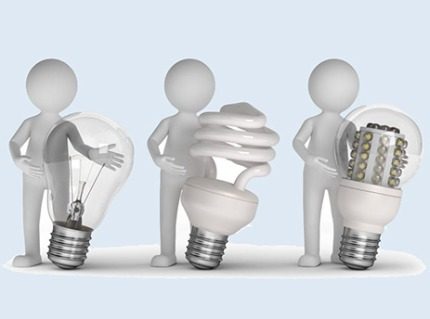
There is a huge variety of general-purpose bulbs or abbreviated LON: regular size or miniature for local lighting.
By type of execution, the bulb may be:
- painted;
- frosted glass;
- mirror.
LON modifications can have bulbs not only with colorless, but also with multi-colored transparent glass. As a rule, they are used for decorative purposes.
Models with frosted glass cylinders are in demand, giving a soft, uniform light, which is especially suitable for lighting bedrooms and children's rooms.
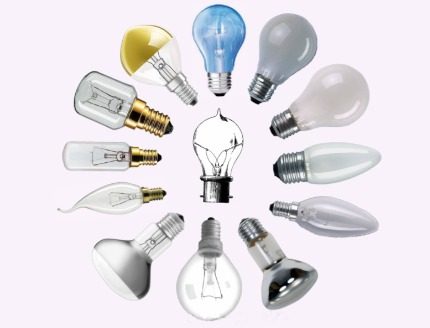
In mirror devices, part of the cylinder is coated with a special composition that reflects the light, directing it in a narrow stream.
Such devices are often inserted into ceiling lights, since they allow light to be cast only downward, without lighting or heating the upper surface.
Light bulbs operating on 12, 24, 36 V require a minimum consumption of electricity, but give a very dim weak light. They are used in flashlights or for emergency lighting.
Technical characteristics of LON:
- light output - 9-19 Lm / W;
- power - 25-150 watts;
- the average operating period is a thousand hours at a voltage of 220 V;
- Efficiency - less than 30%.
The advantages include low price, simple and affordable installation, pleasant yellowish light lighting.
The inconvenience of incandescent devices is much greater: they are fragile, they quickly burn out when voltage drops, in addition, their surface heats up very much, which can cause a fire.
There is an article on our website in which we spoke in detail about the varieties of incandescent lamps, their labeling, and also outlined the main criteria for their choice. More details - go to the link.
A variety of halogen light sources
A similar type of device with a base has a design similar to incandescent lamps, but instead of inert gas, the flask is filled with compounds of iodine, bromine or other halogens. This allows you to reduce the evaporation of the heating element, as well as increase its temperature.
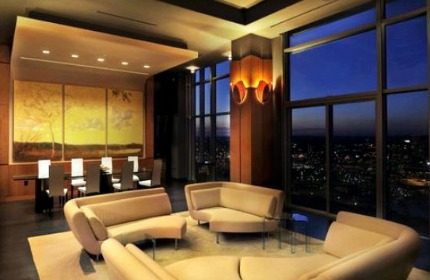
In addition to base lamps, other options, such as linear halogens that have the shape of a tube, are widely used. Shockproof models with intense light are used for street floodlights.
Capsule low-voltage devices with miniature dimensions are popular. They are often used for chandeliers or suspended ceilings, however, network connection should be through a special transformer.
Another variety is reflective devices, in the construction of which a special reflector is used - most often an aluminum disk. It allows you to adjust the angle of incidence of the light beam, directing it to the desired area of the room.
Such devices are used to install ceiling lights, since they allow to exclude heating of the upper surface.
Specifications halogen:
- power - 1-20 W;
- color rendering index - 100%;
- flask heating - 500 ° C;
- light output - 15-22 Lm / W;
- works in the range from -60 to +100 ° C;
- service life - 2000-4000, when using a transformer up to 8000 hours;
- Efficiency - 50-80%.
Among the advantages of this category of devices is a rather long service life, as well as the possibility of manufacturing miniature models that give bright light.
They have excellent color rendering, and modern technology can give the radiated radiance both a warm and a cold hue.
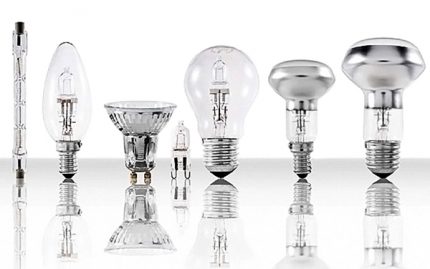
The disadvantages include strong heating of the surface of the flask, because of which it is made of heat-resistant quartz glass. But in this case, it is not recommended to allow their contact with the ceiling or the walls of the lamp.
Halogens are very sensitive to pollution - touching them with their bare hands can cause burnout or even breakdown of the bulb. They also do not tolerate power surges.
And how to choose a good halogen lamp, read in this stuff.
Fluorescent tubes (CFL and LL)
The devices consist of a bulb whose inner surface is coated with a phosphor.The container where the electrodes are located is filled with a mixture of mercury vapor with an inert gas.
For start-up, a special unit is used - electronic or mechanical ballast. When turned on, a charge is sent inside the flask, which causes the formation of ultraviolet waves, under the influence of which the phosphor begins to glow evenly.
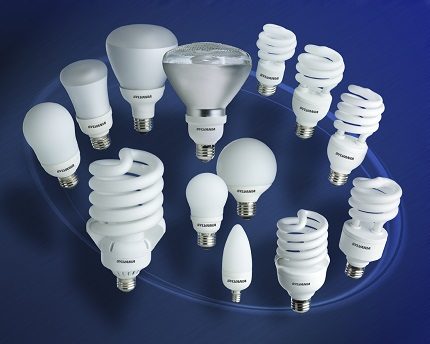
Models are divided into two types:
- linear devices (LL) - bulky tubes, at the ends of which there are two pins;
- compact lamps (CFL), having the form of a twisted spiral, in which the launch block is hidden in the base.
Marking G means devices with a pin design, and the letter E - a threaded cartridge.
CFL specifications:
- light output - 40-80 Lm / W;
- power - 15-80 watts;
- service life - 10000-40000 hours.
An important advantage of luminescent is the low operating temperature. Even with the product turned on, you can safely touch it with your bare hand, making it safe to install on any surface.
At the same time, such devices have many negative aspects. First of all, they are not environmentally friendly enough - mercury vapor inside is toxic.
Although in a closed flask they do not have a detrimental effect on a person, broken or burnt out bulbs can be dangerous. Because of this, they need a recycling procedure: they have to return the used products to recycling points, which are not always easy to find.
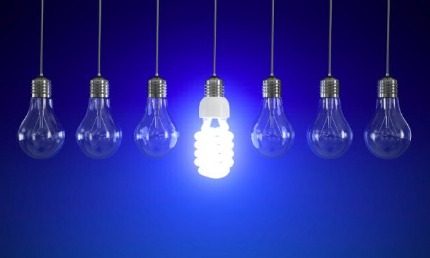
Other disadvantages include:
- Unstable operation at low temperatures. At -10 ° C, even powerful devices shine extremely dimly.
- When you turn on the lamps do not light up immediately, but after a few seconds or minutes.
- Their cost is quite high.
- Work may be accompanied by a low-frequency drone.
- Such models are difficult to compatible with dimmers, which makes it difficult to adjust the light intensity. It is also undesirable to use them together with switches with backlight indicators.
- Although the service life is quite long, it is significantly reduced with frequent on and off.
In addition, the light flux emitted by these devices is very pulsating, which tires the eyes.
You can read more about the design of fluorescent lamps, their advantages and disadvantages here.
LED bulbs (LED)
The basis of the design of the diode bulbs is semiconductor crystals, which emit light rays as a result of the pn junction.
As a rule, they involve at least five diodes that are connected to the installation board. Functioning takes place using a driver that converts alternating current into direct current.
The lamps practically do not heat up during operation, since special parts are provided for the removal of heat - radiators. Depending on the modification, the devices are equipped with screw or pin caps.
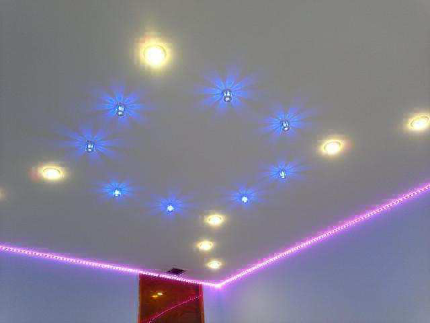
Types of LEDs include filament devices. Outwardly, they resemble ordinary incandescent lamps, but instead of a spiral, semiconductor elements are installed in them, strung on a rod, which is placed in a flask with an inert gas.
So that such a device can be screwed into the cartridge, it is complemented by a traditional threaded base. Such models allow you to combine retro design with higher technical characteristics, such as energy efficiency, durability, environmental friendliness.
Autonomous LED lamps powered by solar panels are also gaining popularity. They recharge during daylight hours and automatically turn on when dark. Similar models can operate in a wide temperature range from -30 to +50 ° C.
Technical characteristics of LED lamps:
- power - 3-30 W;
- service life - 30000-50000 hours;
- light output - 100-120 Lm / W;
- light stream - 250-2500 Lm.
LEDs can dramatically reduce lighting costs by up to 85%, while they work there is no thermal, ultraviolet and infrared radiation.
Since harmful substances are not used in their manufacture, they are considered environmentally friendly and do not require special disposal.
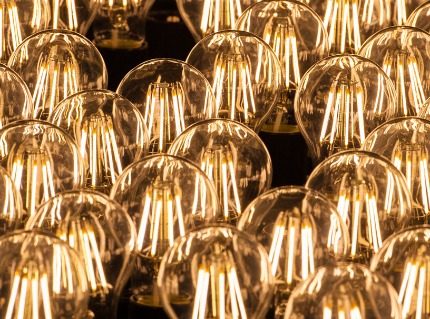
Unlike fluorescent lamps, these devices light up instantly, in addition, most models lend themselves to dimming, which allows you to set the desired level of light flux intensity.
Among the shortcomings, an extremely high price can be noted, in addition, for ordinary lamps, a directed stream of light; filament devices are deprived of this drawback. Lighting a room usually requires several sources at once.
We also recommend reading an article in which we spoke in detail about the main characteristics of LED lamps - color temperature and power. Read more - read Further.
Rules for choosing the best lamp
Choosing models for organizing lighting in residential premises, one should take into account not only the type to which the light bulb belongs, but also a number of other factors, namely:
- basement device;
- power;
- color rendering index;
- light output;
- light flux stability coefficient;
- Operating conditions.
Devices intended for connection with a cartridge have a common part - a base with which fasteners with wires are carried out. In order for the lamp to be installed in the socket, it is important to pay attention to the labeling of this element.
Among the threaded connections, the most popular are three types: E14 minion, E27 medium in size, and large E40. The second option was most widely used, while the latter is usually used for street lighting.
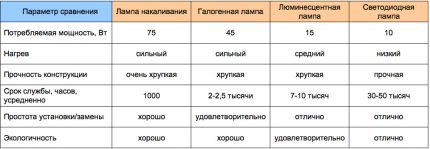
In miniature fluorescent and halogen lamps, G caps are often found, which are mounted in sockets with 2-4 pins. There are many options for such devices of different sizes, of which are especially in demand. modifications G4, G9, G23, 2G10, 2G11.
An important criterion is the lamp power; this indicator is indicated on the cylinder or base. If we take the same type of devices, then the light intensity depends on this value.
However, this rule does not work if you take devices of different types: the brightness of the LED with a power of 5-6 W is almost equal to the glow of a 60-watt incandescent lamp.
Luminous efficiency shows the number of lumens of light that a lamp with a power of 1 Watt produces.
This factor is closely related to the energy efficiency of the device: a luminescent device produces 600 lm at a power of 10-11 W, while an incandescent device will require approximately 60 W for a similar light flux.
The design of the luminaire and lamp also has an effect. Often models of modern chandeliers or sconces are specially made for a certain type of devices, for example, halogen ones. In this case, the manufacturer usually indicates in the instructions the characteristics of the required lamps.
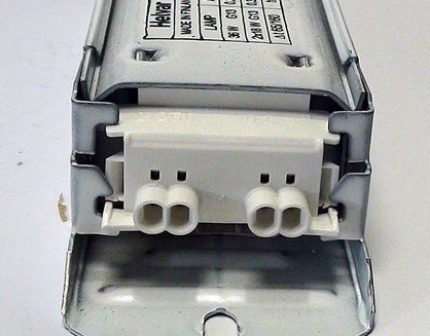
Certain types of devices also demonstrate increased sensitivity to voltage drops, which must be taken into account when living in regions where there are problems with the power grid.
There is also a difference caused by color temperature.
There are several standards for the most common markings:
- 2700 K means a warm shade similar to incandescent lamps;
- 4000 K - daylight in a neutral tone;
- 6500 K is a cold option.
Color Rendering Index Ra displays the correct color perception of the environment when illuminated by this type of lamp. As a rule, this indicator is indicated on the package, for example, 80 Ra at the LEDs.
Light flow stability coefficient. This factor manifests itself during the entire period of operation of the device, during which the brightness should decrease by no more than 30% of the nominal.
Such an indicator is of particular relevance for LEDs that do not burn out, but gradually lose the light intensity.
So, if at the beginning such a device emits 1000 lumens of light, then at the end of its service life this indicator should be at least 70% of the original, that is 700 Lm.
The best choice for different rooms
Interior designers recommend using compact LEDs or low voltage miniature halogens for suspended or suspended ceilings.
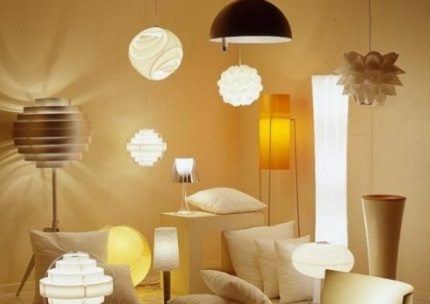
Almost all types of lighting fixtures can be used in chandeliers and other pendant structures. If the luminaires are made of fusible materials, it is better to use LED- or fluorescent sources.
The best option for sconces are small halogens, fluorescent models or traditional incandescent lamps. Often in such devices decorative modifications are used with flasks in the form of drops, flames, balls.
For illumination, small LED bulbs or compact halogen ones, operating from a transformer, are suitable.
In living rooms, a combination of several lighting fixtures is usually used. A ceiling or pendant chandelier is complemented by a sconce, a floor lamp, a decorative table lamp, and built-in lamps.
It is desirable to equip the main device dimmer, which will muffle its intensity.
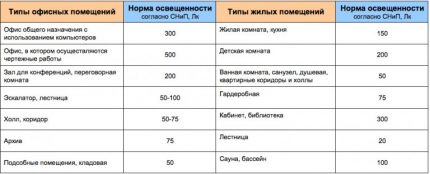
In outdoor floodlights, linear halogen devices are predominantly used. Light decoration of the yard or plot is also possible with the use of LEDs, including those powered by solar panels, or powerful incandescent lamps.
In the basement and cellar, where there is usually a high level of humidity, it is necessary to use lamps with waterproofing and a fully enclosed lampholder.
To prevent short circuits, it is advisable to use a step-down transformer. As a lighting device in this case, one or two 12-volt LED sources are best suited.
Similar requirements apply to lighting fixtures in bathrooms. As a rule, halogen / LED models, as well as incandescent lamps, are used to illuminate the space.
To equip a student’s workplace, a flexible table lamp is usually used to change the direction of the light beam. As a rule, a traditional 60-volt incandescent device with a transparent or opaque bulb is inserted into it.
With a lack of light, it is also desirable to add backlighting with built-in halogen lamps.
Particular attention is required to the choice of light source for greenhouses. As research by scientists has shown, the red and blue spectral regions are especially useful for plants.The first has a powerful effect during the flowering and ovary season of vegetables, the second - contributes to their active growth and development.
It is easiest to reproduce this light range with the help of special LED lamps. They can be made independently or purchased in a store.
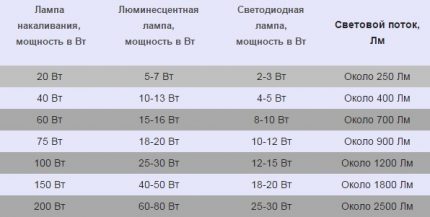
When choosing a model, you should pay attention to the shade of the emitted rays. Typically, this factor depends on user preferences.
Nevertheless, designers recommend choosing a “cozy” warm light for the living room or bedroom, while it is chilly for the office or office space.
When determining the lamp power, it is necessary to take into account not only the area of the room for which it is intended, but also the degree of the natural level of lighting: in darkened spaces with windows to the north, more powerful appliances are installed.
It influences the choice and color scheme of the interior: for rooms with dark walls, more powerful lamps are needed.
Conclusions and useful video on the topic
The video below details the main characteristics of various types of light sources:
The continuation of the story, where we are talking about options for lamp caps and features of their application:
Despite the fact that light bulbs are elementary appliances, their role in creating a comfortable and cozy living environment is difficult to overestimate. A correctly selected device will create comfortable lighting, which is an integral part of the comfort in the home.
The lamp will stably serve for a long time, perfectly complementing a chandelier or other lamp. In addition, an energy-saving device will reduce the amount of utility bills due to energy savings.
Still have questions about the topic of the article? Or can you add material with interesting information about lighting sources? Please leave your comments, share experiences, ask questions in the block below.

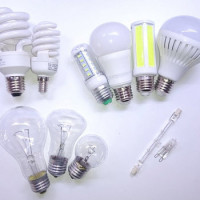 Which bulbs are best for the home: which are + rules for choosing the best bulb
Which bulbs are best for the home: which are + rules for choosing the best bulb 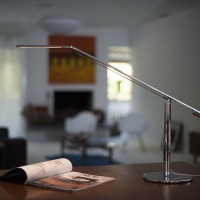 LED table lamps: types, selection rules + review of the best manufacturers
LED table lamps: types, selection rules + review of the best manufacturers 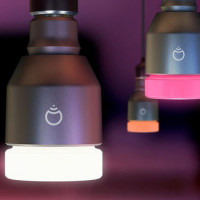 Smart lamp: features of use, types, device + overview of the best models of bulbs
Smart lamp: features of use, types, device + overview of the best models of bulbs 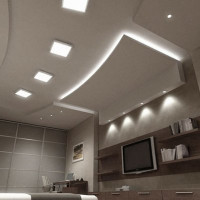 Bulbs for suspended ceilings: rules for the selection and connection + layout of lamps on the ceiling
Bulbs for suspended ceilings: rules for the selection and connection + layout of lamps on the ceiling 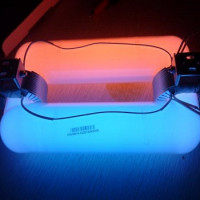 Induction lamps: device, types, scope + rules of choice
Induction lamps: device, types, scope + rules of choice 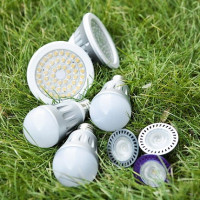 LED lamps for the home: which diode bulbs are better, LED lamp manufacturers overview
LED lamps for the home: which diode bulbs are better, LED lamp manufacturers overview  How much does it cost to connect gas to a private house: the price of organizing gas supply
How much does it cost to connect gas to a private house: the price of organizing gas supply  The best washing machines with dryer: model rating and customer tips
The best washing machines with dryer: model rating and customer tips  What is the color temperature of light and the nuances of choosing the temperature of the lamps to suit your needs
What is the color temperature of light and the nuances of choosing the temperature of the lamps to suit your needs  Replacement of a geyser in an apartment: replacement paperwork + basic norms and requirements
Replacement of a geyser in an apartment: replacement paperwork + basic norms and requirements
Science does not stand still, and a huge variety of types of lamps with their advantages, disadvantages, as well as features allows you to choose the best option for saving, efficiency, design. I prefer LED and fluorescent lamps. I recall with horror how incandescent bulbs shattered when turned on. I suppose that this arose from exceeding the permissible voltage and the structural features of the incandescent lamp. The chandelier had to choose not in beauty, but primarily in the direction of the ceiling. So that they are “deployed” top to avoid injuries.
LED lamps are simply super-inventions, but for some reason they have been getting to our market for some time. Although the technology is not new at all. It is high time to abandon incandescent lamps, as historically obsolete kerasin and oil ones were abandoned in due time. And mercury, in my opinion, is not very suitable for an apartment, because not completely safe both in terms of operation and in terms of disposal. I personally have long translated all the lighting in the apartment to LED.